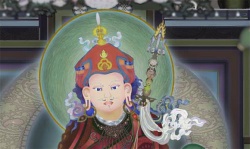Difference between revisions of "Three modes of liberation"
Jump to navigation
Jump to search
| Line 17: | Line 17: | ||
{{RigpaWiki}} | {{RigpaWiki}} | ||
| − | [[Category: Dzogchen]] | + | [[Category: Dzogchen]]{{BuddhismbyNumber}} |
Latest revision as of 10:21, 22 April 2014
The three modes of liberation describe degrees of increasing naturalness in the liberation of thoughts and emotions through the mastery of Dzogchen practice.
The three modes of liberation that are specifically mentioned are:
- Liberation through recognition of thoughts (Tib. ཤར་གྲོལ་, Wyl. shar grol), like recognizing an old friend in a crowd
- Liberation where the thought frees itself, or self-liberation (Tib. རང་གྲོལ་ , Wyl. rang grol), like a snake uncoiling and unwinding its own knots
- Liberation of thoughts as dharmakaya, without their bringing either benefit or harm (Tib. ཕན་མེད་གནོད་མེད་དུ་གྲོལ་བ་ , Wyl. phan med gnod med du grol ba), like a thief entering an empty house
References & Further Reading
- His Holiness the Dalai Lama, Dzogchen : The Heart Essence of the Great Perfection, published by Snow Lion, ISBN 1-55939-156-1, pages 83-84, and pages 186-187.
- His Holiness the Dalai Lama, Mind in {Comfort and Ease: The Vision of Enlightenment in the Great Perfection (Somerville: Wisdom Publications, 2007), pages 223-224.
- Sogyal Rinpoche, The Tibetan Book of Living and Dying, revised and updated edition, Harper San Francisco and also Rider, 2002, ISBN 0-7126-1569-5, pages 167-170
